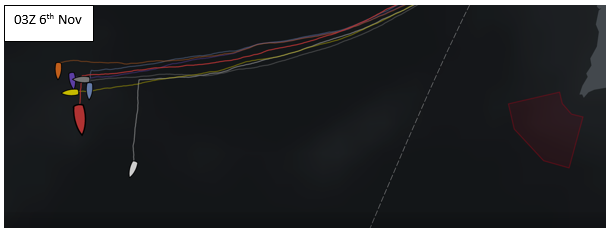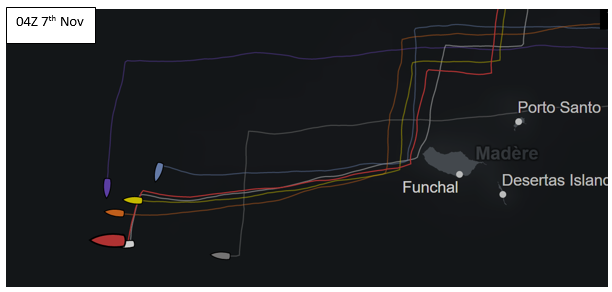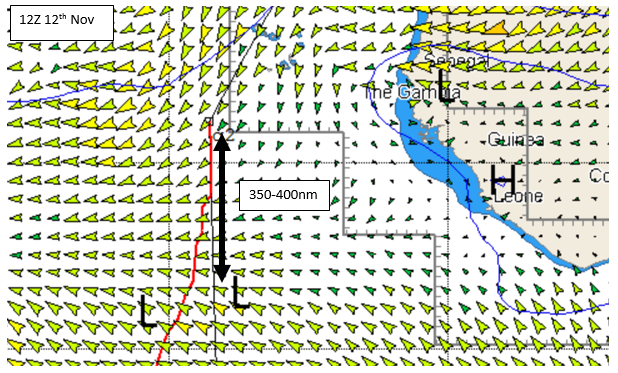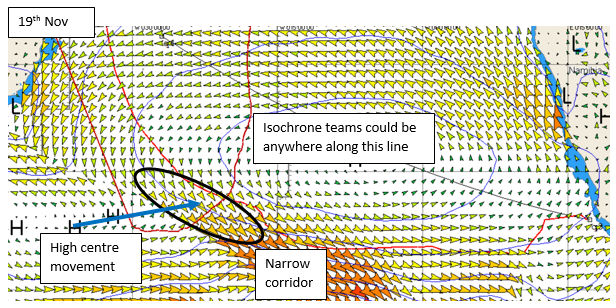Engage cloaking device
Nearly a week into Leg 2 of the Volvo Ocean Race and for some it has been a baptism of fire, as they progress to longest time they have been offshore. For others, they will be settling back into their old offshore way of life.
As the boats approach the doldrums teams are using their stealth mode, so let’s take a look back at who made what decisions and what is making them go stealth.
Fast and Furious start
Once again the leg start proved eventful. As discussed in the start day preview, it was initially going to be all about the sail choices and the majority of the teams kept it simple with their J1 and then deploying on to their Fractional (FR0) kite. Only Vestas didn’t, and tried to hold their Masthead (MH0), suffering speed and height wise to exit the river.
Onwards they charged, all peeling to their A3 at slightly different times and heading out to the stronger breeze. All the teams were pretty much on the money speed wise so next came the first gybe in the middle of the night in 30 plus knots. Who is going to gybe south when and was their going to be a ‘Great Divide’?
MAPFRE was the first gybe taking the lifting breeze early and choosing to stick in fractionally stronger wind. The boats that gybed later came down on a better shift, as a result when they gybed back west there was barely anything in it.
As the teams headed towards Madeira they would have been running routing looking at their options to see if the options to go east were there. But it became pretty clear that the low pressure off the African coast was going to be a blocker and now it was about making gains to the best position to cross the doldrums
Gybe off, not the Great Divide.
We all looked with anticipation to this leg to provide some new and interesting outcomes but ultimately that wasn’t the case. The Great Divide became a gybe off as the majority of teams positioned to make gains off the acceleration and shift provided by Madeira. Interestingly here, Akzonobel was one team that chose not to.
The result was very little positional change for them, in fact a small gain on Brunel and probably a considerably more rested crew.
West is Best
With the extreme easterly route firmly off the table then it all became about getting west and picking your moments to do so. What we can see is some significant differences in the number of manoeuvres different teams chose to do but also the wind direction teams would choose to gybe on.
Turn the Tide made some of the biggest losses here holding on to a poor angle heading west too often for too long.
Dongfeng and MAPFRE were probably the most aggressive about their gybes completing 11 and 9 respectively compared to Vestas and Akzonobel who made the biggest gains with 3 and 6 gybes respectively. It’s easy to look at this and consider that picking the manoeuvres alone was key, however reports off the boats and satellite imagery reveal that there was plenty of cloud activity and each individual boat was getting their own unique micro-system.
The teams all set up between 26-28 W to charge south in order to avoid the band of lighter winds created by a shallow low pressure developing off the African coast. It has then been 2 days of cloud bobbing and some subtle re-positioning.
Stealth Mode
You can be forgiven for thinking in the last 24 hours that Turn the Tide on Plastic had fallen off the face of the earth or at least the electronic version. But, like something out of Star Trek they put themselves into stealth, meaning for 24 hours their position is hidden from the public and the other teams. Just as they appear back on the map Dongfeng have played their card.
Stealth mode can be used once a leg by every team and gives the opportunity for a team to make a move without anyone knowing, so rather than planning it immediately after the normal position reporting time they have a 24 hour period to do what they want. That is assuming they are not within AIS range typically 10-12 nm.
As Dongfeng lead into the doldrums by playing their stealth card they are limiting the information the others have in the area. It is always good to see if the boat ahead is slowing down. So while it might not be about hiding their manoeuvres, it may be about not giving other teams a better or earlier escape route.
Doldrums Yo-Yo
The teams will be heading into the Doldrums next, an area of converging winds where the South Easterly trades meet the North Easterly trades and the air rises, creating deeply unstable conditions, and is dominated by clouds and thunderstorms. At the moment the area looks relatively narrow and not too active but as usual safer west.
Crews will be watching the RADAR intently to determine the best way through this 350-400nm cloud mine field. You can see clearly that winds are still stronger in the west than the east and believe me there are times when the only direction you can go is west or east so it is pretty important to understand where you are trying to get as well as have your best educated guess on how any individual cloud is going to get you there.
A 1nm gain in the doldrums can easily convert to 10nm as whoever pops out first will get into a building breeze first and lifting breeze allowing teams to get on to their fastest setup first.
St Helena High
Once through here it will be the charge south initially slightly on the wind and then fast reaching. Moving throughout this long southerly run will be key, peeling between sails at the right moment, boat speed will be king and we will likely see some extension here by the faster teams as they set up to negotiate the St Helena High.
The sister high pressure system of the Azores pretty much blocks the route to Cape Town and it is slow going to go through it so you have to go round it as we described in the preview.
The question will be how the system sets up to traverse around it and this is where the fleet could get split in two and miss a weather window as a the St Helena High looks sets to have two centres with a narrow corridor allowing the teams to cut the corner and head SE. However, that corridor is closing and will close out on those that are back of the fleet earlier.
It is difficult to predict what is going to happen 9 days out in the Southern Atlantic where conditions are so mobile forecasts have a high level of uncertainty.
Come back next week to find out who dodged the clouds the best and how close are they going to get to ICE ICE BABY!!!




















